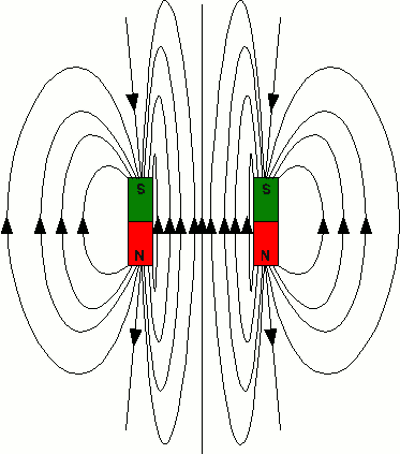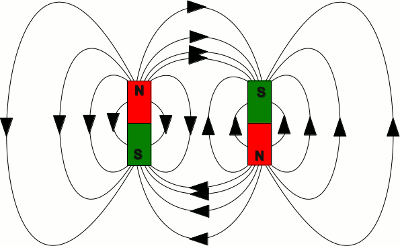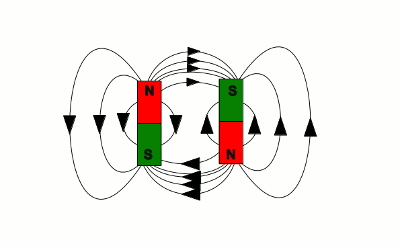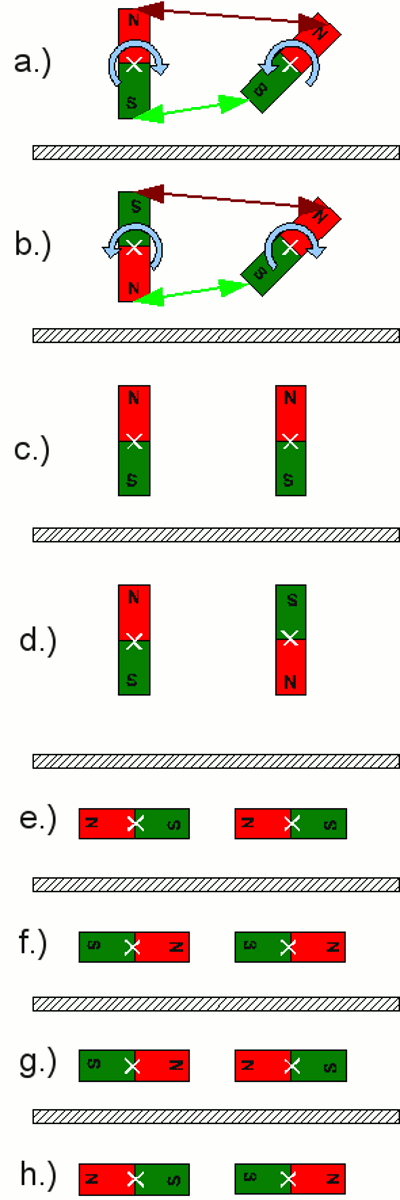|
|
|
|
News The Project Technology RoboSpatium Contribute Subject index Download Responses Games Gadgets Contact <<< Magnetic permeability Java app magnets >>> Magnets inside magnetic fieldsMagnetic fields of magnets
At the chapter magnetism we already recognized the field of a single bar shaped magnet. Let's have a look at the field of two bar magnets arranged side by side: 
Magnetic field of two bar shaped magnets arranged in parallel to each other. The magnetic north poles are at the bottom, the south poles accordingly at the top. Eye-catching is the fact that the field lines between the magnets are very compact. The field strength is higher at this area than it would be with just one magnet. Above and below the axis between the two magnets, the enforcement of the magnetic field is obvious, too. Less obvious, but also noticeable is the enforcement besides the two magnets. The enforcement of the field strength between the two magnets creates a force repelling the magnets from each other. 
Magnetic field lines of two bar magnets arranged in antiparallel mode. The north pole of one magnet is at the top, that of the second magnet on the bottom. The field lines between both magnets run from one pole of one magnet to the according antipole of the other magnet. The field line density in the space between the magnets is low, while that near the poles is high. There is an attracting force acting on both magnets. 
When the magnets approach, the field strength at the top and bottom of the arrangement near the poles is enforced while it is weakened in all other points in space. 
When both magnets get in contact due to the attracting force, the magnetic field in a distance from the arrangement is (almost) cancelled out, while there is a high field strength in a small volume around the poles at the top and bottom. The field strength around two magnets arranged in parallel is boosted if the north poles are ponting into the same direction. In an aintiparallel arrangement (the north pole of one magnet is pointing into the direction of the soth ope of the second magnet) the field strength is weakened (nearly to zero at greater distances). If we have a look at many randomly arranged magnets, we will notice almost no magnetic field outside the area of the magnets. Areas with some magnets in parallel arrangement increase the field strength locally, but there will be other groups being in antiparallel arrangement to those group and therefore increasing the field. In addition we have noticed forces between two magnets. Two magnets being arranged in parallel or antiparallel mode repell respectively attract each other. If the axes of the magnets are arranged in an angle to each other, a torque will be noticed furthermore: Interaction of two rotatable mounted magnets:
If the axes of the magnets are arranged with an angle between them like shown at picture a.), a torque is generated. The repelling force of the south poles creates a clockwise pointing torque at the left magnet and a anticlockwise pointing torque at the right magnet. The repelling force of the north poles induce a anticlockwise torque at the left magnet and a clockwise torque at the right magnet. Because of the fact that the distance between the two south poles is smaller than those of the north poles, the resulting torque of the south poles dominates. Added up, there is a clockwise torque at the left magnet and a anticlockwise torque at the right magnet. Looking at picture b.), we see that the different poles are closer to each other and so the attracting force dominates. The lower placed poles attract each other in a stronger way than the upper poles do, because the distance between them is smaller. Accordingly we get a anticlockwise torque at the left magnet and a clockwise torque at the right magnet. There is no torque acting whenever the corresponding poles of both magnets have the same distance to each other, like shown at the pictures c.) - f.), respectively if all poles are arranged at the same axis, shown at the pictures g.) + h.). Conditions d.) + g.) + h.) are instable like a needle balanced at the needle point. If one of those magnets starts twisting slightly, both magnets tilt until reaching one of the conditions c.), e.) or f.). <<< Magnetic permeability Java app magnets >>> News The Project Technology RoboSpatium Contribute Subject index Archives Download Responses Games Links Gadgets Contact Imprint |
|
|